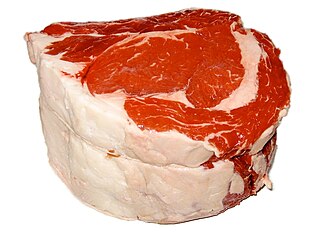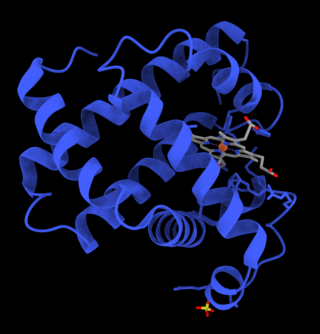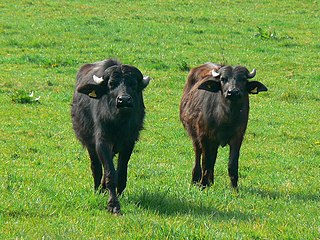
Meat science is the study of meat, including its production, preparation and preservation. [1] Some meat scientists are studying methods of producing artificial meat such as cultures of muscle cells. [2]

Meat science is the study of meat, including its production, preparation and preservation. [1] Some meat scientists are studying methods of producing artificial meat such as cultures of muscle cells. [2]
Drip loss is the leakage of myofibers and loss of iron, protein, and water during the transition of muscle to meat. [3] Drip loss impacts the quality and palatability of meat, and has been an issue for pork and chicken. [3] Drip loss is in part governed by the water holding capacity of meat. [4]

Meat is animal tissue, often muscle, that is eaten as food. Humans have hunted and farmed other animals for meat since prehistory. The Neolithic Revolution allowed the domestication of animals, including chickens, sheep, goats, pigs, horses, and cattle, starting around 11,000 years ago. Since then, selective breeding has enabled farmers to produce meat with the qualities desired by producers and consumers.

Poultry are domesticated birds kept by humans for the purpose of harvesting animal products such as meat, eggs or feathers. The practice of raising poultry is known as poultry farming. These birds are most typically members of the superorder Galloanserae (fowl), especially the order Galliformes. The term also includes waterfowls of the family Anatidae but does not include wild birds hunted for food known as game or quarry.

Beef is the culinary name for meat from cattle. Beef can be prepared in various ways; cuts are often used for steak, which can be cooked to varying degrees of doneness, while trimmings are often ground or minced, as found in most hamburgers. Beef contains protein, iron, and vitamin B12. Along with other kinds of red meat, high consumption is associated with an increased risk of colorectal cancer and coronary heart disease, especially when processed. Beef has a high environmental impact, being a primary driver of deforestation with the highest greenhouse gas emissions of any agricultural product.

The chicken is a large and round short-winged bird, domesticated from the red junglefowl of Southeast Asia around 8,000 years ago. Most chickens are raised for food, providing meat and eggs; others are kept as pets or for cockfighting.

Myoglobin is an iron- and oxygen-binding protein found in the cardiac and skeletal muscle tissue of vertebrates in general and in almost all mammals. Myoglobin is distantly related to hemoglobin. Compared to hemoglobin, myoglobin has a higher affinity for oxygen and does not have cooperative binding with oxygen like hemoglobin does. Myoglobin consists of non-polar amino acids at the core of the globulin, where the heme group is non-covalently bounded with the surrounding polypeptide of myoglobin. In humans, myoglobin is found in the bloodstream only after muscle injury.

Creatine is an organic compound with the nominal formula (H2N)(HN)CN(CH3)CH2CO2H. It exists in various tautomers in solutions. Creatine is found in vertebrates where it facilitates recycling of adenosine triphosphate (ATP), primarily in muscle and brain tissue. Recycling is achieved by converting adenosine diphosphate (ADP) back to ATP via donation of phosphate groups. Creatine also acts as a buffer.

Cultured meat, also known as cultivated meat among other names, is a form of cellular agriculture where meat is produced by culturing animal cells in vitro. Cultured meat is produced using tissue engineering techniques pioneered in regenerative medicine. Jason Matheny popularized the concept in the early 2000s after he co-authored a paper on cultured meat production and created New Harvest, the world's first non-profit organization dedicated to in-vitro meat research. Cultured meat has the potential to address the environmental impact of meat production, animal welfare, food security and human health, in addition to its potential mitigation of climate change.

Beef aging or ageing is a process of preparing beef for consumption by aging it, in order to break down the connective tissue within the meat.

Breed broiler is any chicken that is bred and raised specifically for meat production. Most commercial broilers reach slaughter weight between four and six weeks of age, although slower growing breeds reach slaughter weight at approximately 14 weeks of age. Typical broilers have white feathers and yellowish skin. Broiler or sometimes broiler-fryer is also used sometimes to refer specifically to younger chickens under 2.0 kilograms, as compared with the larger roasters.

In culinary terms, white meat is meat which is pale in color before and after cooking. In traditional gastronomy, white meat also includes rabbit, the flesh of milk-fed young mammals, and sometimes pork. In ecotrophology and nutritional studies, white meat includes poultry and fish, but excludes all mammal flesh, which is considered red meat.

Meat floss, also known as pork or yuk sung, is a dried meat product with a light and fluffy texture similar to coarse cotton, originating from China.

Poultry farming is the form of animal husbandry which raises domesticated birds such as chickens, ducks, turkeys and geese to produce meat or eggs for food. Poultry – mostly chickens – are farmed in great numbers. More than 60 billion chickens are killed for consumption annually. Chickens raised for eggs are known as layers, while chickens raised for meat are called broilers.

The environmental impacts of animal agriculture vary because of the wide variety of agricultural practices employed around the world. Despite this, all agricultural practices have been found to have a variety of effects on the environment to some extent. Animal agriculture, in particular meat production, can cause pollution, greenhouse gas emissions, biodiversity loss, disease, and significant consumption of land, food, and water. Meat is obtained through a variety of methods, including organic farming, free-range farming, intensive livestock production, and subsistence agriculture. The livestock sector also includes wool, egg and dairy production, the livestock used for tillage, and fish farming.
Pale, soft, exudative meat, or PSE meat, describes a carcass quality condition known to occur in pork, beef, and poultry. It is characterized by an abnormal color, consistency, and water holding capacity, making the meat dry and unattractive to consumers. The condition is believed to be caused by abnormal muscle metabolism following slaughter, due to an altered rate of glycolysis and a low pH within the muscle fibers. A mutation point in the ryanodine receptor gene (RYR1) in pork, associated to stress levels prior to slaughter are known to increase the incidence of PSE meat. Although the term "soft" may look positive, it refers to raw meat. When cooked, there is higher cook loss and the final product is hard, not juicy.

Zilpaterol is a β2 adrenergic agonist. Under its brand name, Zilmax, it is used to increase the size of cattle and the efficiency of feeding them. Zilmax is produced by Intervet, a subsidiary of Merck & Co., and marketed as a "beef-improvement technology". Zilpaterol is typically fed in the last three to six weeks of cattle's lives, with a brief period before death for withdrawal, which allows the drug to mostly leave the animal's tissues.

The Ayam Cemani is a rare breed of chicken from Indonesia. They have a dominant gene that causes hyperpigmentation (fibromelanosis), making the chicken mostly black, including feathers, beak, and internal organs. The Cemani is a very popular gamecock for cockfighting in Bali because their thighs have much more muscle compared to other chickens, which leads to them being much faster.

Buffalo meat, also known as buffalo beef, is the meat of the water buffalo, a large bovid, raised for its milk and meat in many countries including India, Nepal, Pakistan, Bangladesh, Philippines, Bulgaria, Italy, Russia, Czech Republic, Slovakia, Australia and Egypt.
Woody breast is an abnormal muscle condition that impacts the texture and usability of chicken breast meat. The affected meat is described as tough, chewy, and gummy due to stiff or hardened muscle fibers that spread through the filet. The specific cause is not known but may be related to factors associated with rapid growth rates. Companies often use a three-point scale to grade the woodiness of a particular breast. Although distasteful to many, meat that exhibits woody breast is not known to be harmful to humans who consume it. When detected by suppliers, product shown to have the condition present may be discounted or processed as ground chicken. Woody breast has become so prevalent in the broiler industry that the U.S. Poultry & Egg Association has helped fund four research projects with over $250,000 in an effort to understand and address the condition. Estimates placed the total cost to the global industry as high as US$1 billion in 2020 for losses associated with managing the woody breast condition in broiler chickens.
A meat diaper or meat absorbent pad refers to the absorbent pad found in pre-packaged meats. Its purpose is to absorb the juices released from the meat during storage and transportation, helping maintain the meat's appearance and reduce spoilage. The case-ready meat almost always contain one or two meat diapers which absorb and retain the "purge", or the juices, blood, and other fluids that seep from the meats which may be unsightly for the consumer, leaks, is messy, and is often contaminated with bacteria.
Meat water holding capacity (WHC) refers to the ability of meat to retain moisture including moisture inherent to the muscle tissue and any fluids that may be added to the meat during processing. The WHC characteristic corresponds to meat juiciness and meat tenderness.